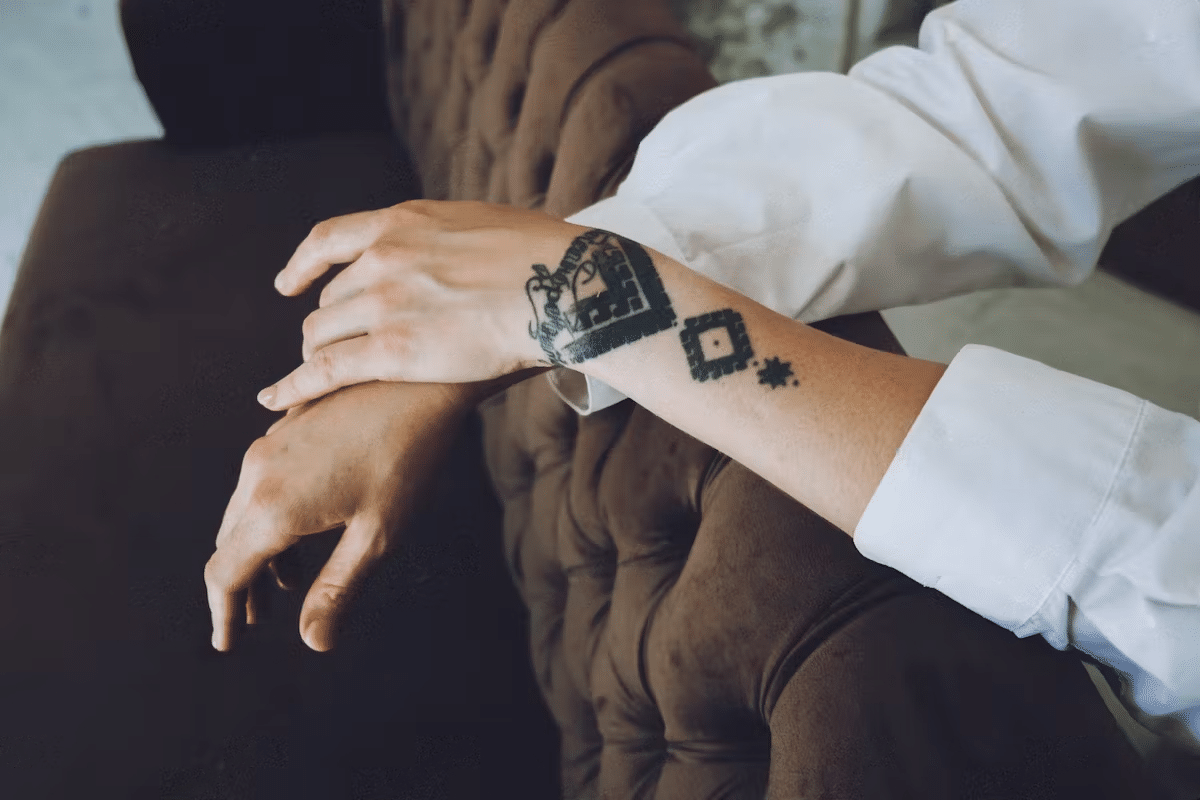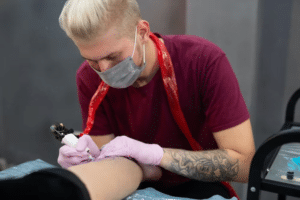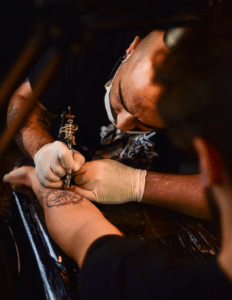
Do you have a tattoo that you are no longer proud of? You may be considering lightening it with white ink but have heard that this is not recommended by many tattoo artists.While white ink can be used to lighten tattoos, its visibility and longevity make it a less desirable option compared to other methods.In this article, we will discuss why artists avoid lightening tattoos with white ink and explore other ways to lighten them.
Why Artists Avoid Lightening With White Ink?

White ink is not a popular choice for lightening tattoos as it has
a tendency to discolour and fade over time. Additionally, white ink is
difficult to blend with existing tattoo colours, leading to patchy or uneven results.Furthermore, controlling the amount of lightning with white ink can be tricky as each application may produce different results.These risks make it less desirable than laser removal, allowing gradual lightening without disrupting the original design. Tattoo artists avoid using white ink for lighting because they prefer more reliable methods that will produce better results for their clients.
Poor Visibility
Poor visibility can be a serious issue for those with tattoos, especially when the original design was heavily saturated or dark. Tattoos that were done in black ink, for example, can become difficult to see if they are not exposed to enough light.Additionally,
white ink will often appear too pale on the skin and may even disappear completely depending on the skin tone of the individual. This can result in a tattoo that is difficult to make out and may need to be reworked or removed entirely if it becomes too faint to distinguish.Poor visibility can also arise from age, improper care, or exposure to UV rays which can cause fading and discolouration over time. In order to avoid this problem, individuals should ensure their tattoo artist uses
high-quality ink and take proper care of their tattoos after they have been applied.
Poor Longevity
Poor longevity is a common problem for tattoos done in white ink. Unlike black, which will last for years without fading,
white ink can start to stain relatively quickly and become yellow or brown over time.Additionally, tattoos done in white ink may be more prone to fading in direct sunlight or when exposed to certain chemicals. For these reasons, it is important that individuals take proper care of their tattoos after they have been applied if they wish to maintain their original design.This may include avoiding long sun exposure and regularly moisturising the skin around the tattoo to prevent drying out. Additionally, individuals should ask their artist about any special instructions they should follow in order to preserve the longevity of their tattoo.
Lightening Tattoos With White Ink
Lightening tattoos with white ink can be a challenging and time-consuming process. In order to achieve the desired look,
many sessions are typically required.Throughout each session, a small amount of white ink is carefully added over the existing tattoo, gradually lightening it until the desired result is achieved. However, due to poor longevity, it is important that individuals take extra care of their tattoos following each session if they want to preserve the look.This may include avoiding direct sunlight and regularly moisturising the skin around the tattoo. Additionally, individuals should ask their artist about any special instructions they should follow in order to maintain their original design.With patience and proper care, lightening tattoos with white ink can be done successfully, but it’s important to keep in mind that this process may not always yield perfect results.
As A Client
As a client looking to lighten a tattoo with white ink, it is important to
ensure that the artist you choose has significant experience with the process. Lightening tattoos can be a difficult and lengthy process, and having an inexperienced artist could lead to poor results or even damage to the original design.During each session, a small amount of white ink will be added over the existing tattoo in order to gradually lighten it. It is important to
take extra care of your tattoo during this time by avoiding direct sunlight and frequently moisturising the area.Additionally, clients should inquire about any special instructions from their artist in order to preserve the look of their tattoo. With patience and proper care, tattoos can be successfully lightened with white ink.
As An Artist
As an artist, it is important to be knowledgeable in the art of lightening tattoos with white ink. This process can take multiple sessions and requires patience on both the part of the client and the artist. To achieve optimal results, artists should
use opaque white ink applied in thin layers.When applying the ink, move the machine in small circles for better coverage. It is essential to ensure that each layer has been given enough time to dry before adding another layer.As this technique requires a considerable amount of skill, artists should take the time to practice on their own skin or artificial skin before attempting this technique on a client’s tattoo. With experience and careful attention to detail, artists can create beautiful results when lightening tattoos with white ink.
Other Ways To Lighten Tattoos With White Ink
Lightening tattoos with white ink is a great way to achieve beautiful results. However, there are also other ways to lighten tattoos with white ink that involve more complex processes. For example, some artists use a process called
‘stippling’ to apply multiple layers of thin white lines in the same spot until the desired effect is achieved.Another technique that some artists use is
‘spotlighting’, which involves adding tiny dots of white ink over a larger area to make it appear lighter. Finally, some opt for
‘freehanding’ or hand-drawing a design using only white ink for an artistic effect.All three of these techniques require patience and skill but can give amazing results when done properly. Ultimately, it comes down to personal preference and your artist’s level of experience and expertise when deciding which method works best for you.
Cover Up
Cover-up tattoos are a great way to fix or improve an existing tattoo. This process involves
getting a new tattoo that is designed to cover the old one. The new design should be larger than the original and will usually involve more shading, colour and detail in order to effectively hide it.Depending on the size of the old tattoo,
it may require multiple sessions for optimal results. It’s important to
find an experienced artist who understands how to create a design that will blend in with the existing ink and look natural once completed.For those looking for a complete transformation of their ink, cover up tattoos are an excellent solution.
Conclusion
Ultimately, if you choose to lighten your tattoo with white ink, make sure that you understand the risks involved and have realistic expectations about the longevity of this type of treatment. It may be best to
speak with a professional artist before attempting any sort of procedure on your own, as they will be able to provide expert advice specific to your individual situation.
FAQ
Can you tattoo white over black to lighten it?
The answer is yes! The key to covering up a black tattoo is to choose a colour that will contrast well with the black ink. For example, lighter colours such as white, yellow, or light green will stand out against the darkness of the black ink.
How quickly does white tattoo ink fade?
Tattoo artists in our network have informed us that white ink tattoos fade or change in appearance much faster than tattoos created with black or colourful ink. At times, they take on a particular tint as they age. Some experts say these changes can occur in as few as
45 to 60 days.
How can I lighten my tattoo at home?
Lemon and lime juice are two popular natural tattoo-lightening agents.
Applying freshly squeezed lime or lemon juice 2-3 times on the tattooed area daily can help significantly lighten your tattoo over time.
 Do you have a tattoo that you are no longer proud of? You may be considering lightening it with white ink but have heard that this is not recommended by many tattoo artists.While white ink can be used to lighten tattoos, its visibility and longevity make it a less desirable option compared to other methods.In this article, we will discuss why artists avoid lightening tattoos with white ink and explore other ways to lighten them.
Do you have a tattoo that you are no longer proud of? You may be considering lightening it with white ink but have heard that this is not recommended by many tattoo artists.While white ink can be used to lighten tattoos, its visibility and longevity make it a less desirable option compared to other methods.In this article, we will discuss why artists avoid lightening tattoos with white ink and explore other ways to lighten them. White ink is not a popular choice for lightening tattoos as it has a tendency to discolour and fade over time. Additionally, white ink is difficult to blend with existing tattoo colours, leading to patchy or uneven results.Furthermore, controlling the amount of lightning with white ink can be tricky as each application may produce different results.These risks make it less desirable than laser removal, allowing gradual lightening without disrupting the original design. Tattoo artists avoid using white ink for lighting because they prefer more reliable methods that will produce better results for their clients.
White ink is not a popular choice for lightening tattoos as it has a tendency to discolour and fade over time. Additionally, white ink is difficult to blend with existing tattoo colours, leading to patchy or uneven results.Furthermore, controlling the amount of lightning with white ink can be tricky as each application may produce different results.These risks make it less desirable than laser removal, allowing gradual lightening without disrupting the original design. Tattoo artists avoid using white ink for lighting because they prefer more reliable methods that will produce better results for their clients.



